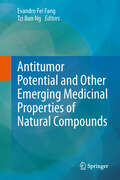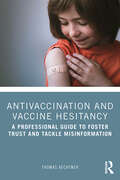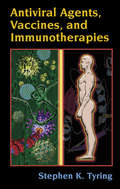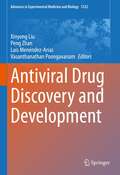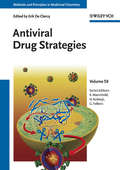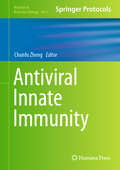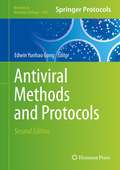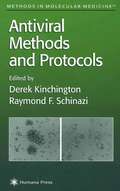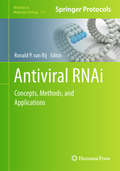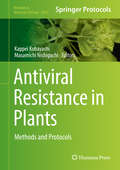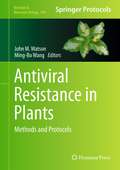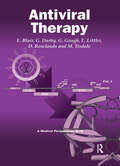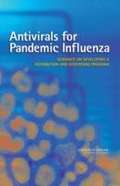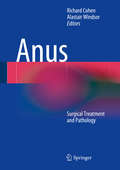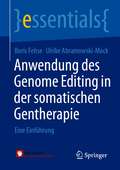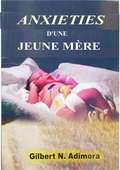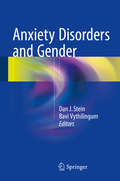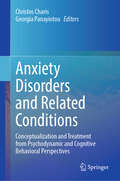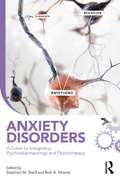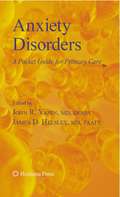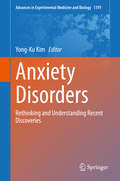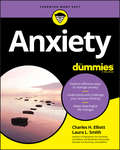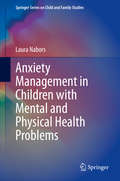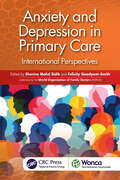- Table View
- List View
Antitumor Potential and other Emerging Medicinal Properties of Natural Compounds
by Tzi Bun Ng Evandro Fei FangThe modern unhealthy diet and lifestyle in conjunction with pathogens, environmental carcinogens and multiple other risk factors increase humans' susceptibility to different diseases exemplified by elevated levels of cancers, cardiovascular and communicable diseases. Screening of potential drugs from medicinal plants and animals provides a promising strategy for the alleviation of the impact of these diseases. Components with potential medicinal applications include RIPs, RNases, lectins, protease inhibitors and numerous small compounds. These compounds have shown both preventive and therapeutic effects for humans. This book is a compilation of articles written by internationally renowned experts exploring the different uses of medicinal compounds in human therapeutics. Here we provide a comprehensive outlook on both qualitative and quantitative studies focusing on medicinal plants and animals, and establishing a link between laboratory research discovery and clinical applications.
Antivaccination and Vaccine Hesitancy: A Professional Guide to Foster Trust and Tackle Misinformation
by Thomas AechtnerThis important book provides a comprehensive guide to understanding vaccine hesitancy, as well as the nuances of antivaccination claims. It is designed to give clinicians and other professionals targeted information to help them address vaccine hesitancy and antivaccination claims, as well as ways of responding to immunisation concerns. Alongside the scientific facts around vaccinations, it considers the historical foundations of modern vaccine scepticism, while offering key insights into the psychology behind vaccine hesitancy and the factors which influence an individual’s decision-making. Separating fact from fiction, the book explores the most well-known antivaccine myths, many of which proliferate online, uncovering ways that counter-vaccine narratives can influence audiences. Importantly, it also outlines the most effective strategies to address both doubts and misinformation, detailing five general principles to improve communications, with tips and guidance to debunk false claims or provide assurance in the face of immunisation doubts. This is essential reading for anyone wishing to really understand the phenomenon of vaccine hesitancy, whether professional, student or general reader, and the methods that can be used to challenge misinformation.
Antiviral Agents, Vaccines, and Immunotherapies
by Stephen K. TyringUnlike any other source on the subject, Antiviral Agents, Vaccines, and Immunotherapies analyzes the benefits and limitations of every available drug, vaccine, and immunotherapy utilized in the prevention and control of viral diseases. This reference provides in-depth reviews of more than 50 drugs and antiviral agents for HIV, human herpesviruses,
Antiviral Drug Discovery and Development (Advances in Experimental Medicine and Biology #1322)
by Xinyong Liu Peng Zhan Luis Menéndez-Arias Vasanthanathan PoongavanamThis book summarizes state-of-the-art antiviral drug design and discovery approaches starting from natural products to de novo design, and provides a timely update on recently approved antiviral drugs and compounds in advanced clinical development. Special attention is paid to viral infections with a high impact on the world population or highly relevant from the public health perspective (HIV, hepatitis C, influenza virus, etc.). In these chapters, limitations associated with adverse effects and emergence of drug resistance are discussed in detail. In addition to classical antiviral strategies, chapters will be dedicated to discuss the non-classical drug development strategies to block viral infection, for instance, allosteric inhibitors, covalent antiviral agents, or antiviral compounds targeting protein–protein interactions. Finally, current prospects for producing broad-spectrum antiviral inhibitors will be also addressed. The book is distinctive in providing the most recent update in the rapidly evolving field of antiviral therapeutics. Authoritative reviews are written by international scientists well known for their contributions in their topics of research, which makes this book suitable for researchers not only within the antiviral research community but also attractive to a broad audience in the drug discovery field. This book covers molecular structures and biochemical mechanisms mediating the antiviral effects, while discussing various ligand design strategies, which include traditional medicinal chemistry, computational chemistry, and chemical biology approaches. The book provides a comprehensive review of antiviral drug discovery and development approaches, particularly focusing on current innovations and future trends.
Antiviral Drug Strategies (Methods and Principles in Medicinal Chemistry #50)
by Raimund Mannhold Gerd Folkers Hugo KubinyiBy focusing on general molecular mechanisms of antiviral drugs rather than therapies for individual viruses, this ready reference provides the critical knowledge needed to develop entirely novel therapeutics and to target new viruses. It begins with a general discussion of antiviral strategies, followed by a broad survey of known viral targets, such as reverse transcriptases, proteases, neuraminidases, RNA polymerases, helicases and primases, as well as their known inhibitors. The final section contains several cases studies of recent successful antiviral drug development. Edited by Erik de Clercq, the world authority on small molecule antiviral drugs, who has developed more new antivirals than anyone else.
Antiviral Drugs
by Wieslaw M. KazmierskiThis book focuses on new small molecule approaches to combat viral infections. The chapters describe the discovery and development from bench through the clinic of relatively recently-approved antiviral drugs and compounds in advanced clinical development. Organized by a virus (such as HIV, HCV, RSV, influenza, HBV and CMV) and written by top academic and industrial authorities in the field, the book provides a unique opportunity to study, understand and apply discovery and development principles and learning without the need for an individual to research, analyze and synthesize all immense sourcing references. Topics showcase challenges and solutions of issues encountered, offering tremendous experience accumulated over many years of research that will be particularly useful to basic and bench scientists as well as clinicians as they continue discovering and developing new drugs and therapies.
Antiviral Innate Immunity (Methods in Molecular Biology #2854)
by Chunfu ZhengThis detailed volume explores a variety of techniques for studying antiviral innate immunity and the type I interferon (IFN-I) signaling pathway. Beginning with guidelines to identify novel proteins from the host or viruses that regulate the antiviral IFN-I signaling pathway, the book continues with common and cutting-edge approaches for identifying novel regulatory factors, posttranslational modifications, as well as click chemistry to detect protein modifications. Other chapters delve into topics such as cytosolic RNA and DNA sensors, magnetic beads, cryo-electron microscopy, zebrafish, humanized mice, and organoids as model organisms to study host-virus interactions, and epidemiological approaches. Written for the highly successful Methods in Molecular Biology series, chapters include introductions to their respective topics, lists of the necessary materials and reagents, step-by-step and readily reproducible laboratory protocols, and tips on troubleshooting and avoiding known pitfalls. Authoritative and practical, Antiviral Innate Immunity serves as an ideal guide for researchers working in this vital area of the virology and innate immunity fields.
Antiviral Methods and Protocols (Methods in Molecular Biology #1030)
by Edwin Yunhao GongAlthough antiviral drugs have been successfully developed for some viral diseases, there remains a clear, unmet medical need to develop novel antiviral agents for the control and management of many viruses that currently have no or limited treatment options as well as a need to overcome the limitations associated with the existing antiviral drugs, such as adverse effects and emergence of drug-resistant mutations. The second edition of Antiviral Methods and Protocols features: All chapters are new and written by experts in the field, reflecting the major recent technical advances in antiviral research and discovery. This edition focuses on many important human viruses, such as human immunodeficiency virus type 1 (HIV-1), hepatitis viruses (hepatitis B and C viruses), herpes viruses, human respiratory syncytial virus (RSV), and influenza virus, while also featuring some important emerging viruses, such as dengue virus, West Nile virus, and chikungunya virus. As a volume in the highly successful Methods in Molecular Biology series, chapters include introductions to their respective topics, lists of the necessary materials and reagents, step-by-step, readily reproducible laboratory protocols, and tips on troubleshooting and avoiding known pitfalls. Comprehensive and cutting-edge, Antiviral Methods and Protocols, Second Edition will serve as an excellent laboratory reference for pharmaceutical and academic biologists, medicinal chemists, and pharmacologists as well as for virologists in the field of antiviral research and drug discovery.
Antiviral Methods and Protocols (Methods in Molecular Medicine #24)
by Raymond F. Schinazi Derek KinchingtonExperienced scientists describe-in an easily-followed format-their state-of-the-art techniques for evaluating antiviral compounds. The assays described include systems for investigating drugs used against herpesviruses, hepatitis viruses, human immunodeficiency viruses, human papillomaviruses, and influenza viruses. These well-tested methods range from cellular assays to some of the most up-to-date molecular approaches for identifying compounds that are active against viral enzymes and the development of viral resistance against drugs currently in use. Timely and comprehensive, Antiviral Methods and Protocols offers today's researchers in academia, clinical departments, and the pharmaceutical industry the powerful, reproducible, and novel methods needed to evaluate compounds effective against both acute and chronic infections.
Antiviral RNAi: Concepts, Methods, and Applications (Methods in Molecular Biology #721)
by Ronald P. RijViruses and RNAi share an intricate relationship at many levels. RNAi is an important antiviral defense mechanism in plants and invertebrates, microRNAs - of viral or cellular origin - affect many aspects of virus biology, and replication of many, if not all, mammalian viruses can be suppressed by RNAi. Antiviral RNAi: Concepts, Methods, and Applications provides a collection of protocols for the analysis of viral small RNAs and natural antiviral RNAi responses as well as for the development and optimization of RNAi-based antiviral drugs. As RNAi is a central regulatory mechanism in the cell, the methods in this volume can also be applied out of the context of a virus infection. Divided into five convenient parts, this detailed volume reviews important basic concepts in the field of antiviral RNAi, provides experimental and bio-informatic tools for the analysis of small silencing RNAs, covers methods to biochemically dissect RNAi-based antiviral defense and viral counter-defense mechanisms, describes methods for the design, expression, and delivery of therapeutic antiviral siRNAs, and finally presents genome-wide RNAi approaches for the identification of factors involved in virus replication. Written in the highly successful Methods in Molecular BiologyTM series format, chapters contain introductions to their respective topics, lists of the necessary materials and reagents, step-by-step, readily reproducible laboratory protocols, and notes on troubleshooting and avoiding known pitfalls. Authoritative and accessible, Antiviral RNAi: Concepts, Methods, and Applications serves as an ideal guide for both novice and experienced researchers alike striving to dissect the role of RNAi in the viral life cycle or to further boost the development of novel therapeutics and experimental tools based on RNAi technology.
Antiviral Resistance in Plants: Methods and Protocols (Methods in Molecular Biology #2028)
by Kappei Kobayashi Masamichi NishiguchiThis detailed book explores strategies that have been developed to combat plant virus infection. Beginning with a section on techniques for identifying and studying the virus resistance gene involved in plant innate immunity, the volume continues by delving into techniques related to novel mechanisms of plant virus resistance, methods for the analysis and practical use of RNA silencing, as well as methods for the development of plant viral vaccines. Written for the highly successful Methods in Molecular Biology series, chapters include introductions to their respective topics, lists of the necessary materials and reagents, step-by-step, readily reproducible laboratory protocols, and tips on troubleshooting and avoiding known pitfalls. Authoritative and practical, Antiviral Resistance in Plants: Methods and Protocols serves as an ideal guide for researchers working to combat the serious threats plant virus diseases represent for agricultural production and beyond.
Antiviral Resistance in Plants: Methods and Protocols (Methods in Molecular Biology #894)
by John M. Watson Ming-Bo WangStudies related to pathogen-mediated virus resistance in plants were instrumental in providing some of the historical observations which ultimately led to the vital discovery of double-stranded RNA (dsRNA)-induced gene silencing or RNA interference (RNAi), which has since revolutionized research on plant-virus interactions. In Antiviral Resistance in Plants: Methods and Protocols, expert researchers in the field detail many of the methods which are now commonly used to study the phenomenon of RNA silencing in relation to viral infections of plants. These include methods and techniques for the isolation and quantitative/qualitative analyses of plant small 21-24 nucleotide RNAs such as small interfering RNAs (siRNAs) and microRNAs (miRNAs) as well as the analysis and manipulation of virus-induced gene silencing (VIGS) in both monocotyledonous and dicotyledenous plants and the use of hairpin RNA (hpRNA) transgenes. Written in the highly successful Methods in Molecular BiologyTM series format, chapters include introductions to their respective topics, lists of the necessary materials and reagents, step-by-step, readily reproducible laboratory protocols, and key tips on troubleshooting and avoiding known pitfalls. Authoritative and practical, Antiviral Resistance in Plants: Methods and Protocols seeks to aid scientists in the further study of this crucially important botanical trait.
Antiviral Therapy
by Dr Eddie Blair Dr Graham Darby Dr Gerlad Gough Dr Eddie Littler Prof D Rowlands Dr Margaret TisdaleA concise summary of vital information on drug targets and current therapy regimes for all of the major viral infections. The book brings together in a single volume aspects of antiviral therapy from diverse areas of research and practice, providing up-to-date coverage of recent developments. Starting from an overview of the history of antiviral chemotherapy, the book goes on to describe the development of drugs against HIV, herpesvirus, respiratory viruses, papillomaviruses and hepatitis virus infections. The drugs currently available are reviewed and possible therapies and drug targets for future prophylactic and therapeutic use are discussed.
Antivirals for Pandemic Influenza: GUIDANCE ON DEVELOPING A DISTRIBUTION AND DISPENSING PROGRAM
by Institute of Medicine of the National AcademiesPlanning for an influenza pandemic, whether it occurs in the near or distant future, will need to take into account many constantly evolving factors. The Institute of Medicine (IOM) Committee on Implementation of Antiviral Medication Strategies for an Influenza Pandemic was asked by the Department of Health and Human Services, (DHHS) to consider best practices and policies for providing antiviral treatment and prophylaxis during a pandemic event. The committee’s report, entitled Antivirals for Pandemic Influenza: Guidance on Developing a Distribution and Dispensing Program, calls for a national and public process of creating an ethical framework for antiviral use within the context of uncertainty and scarcity. It is unclear whether antivirals will work against a pandemic strain as well as they work against seasonal influenza. Also, government stockpiles may not be sufficient for all possible uses in part because antivirals are costly and public health agencies must invest in other important activities, including other medical resources for pandemic influenza. Furthermore, the report identifies the lack of a science-based advisory body to guide decision making during the pandemic, including guidance on all dimensions of antiviral dispensing (for example, prioritization, drug safety, and antiviral resistance). The report also acknowledges the need for diverse methods and sites of dispensing, and discusses their advantages and disadvantages.
Anus: Surgical Treatment and Pathology
by Richard Cohen Alastair WindsorThere is an increase in specialisation within general surgery and now even within its sub specialties. Colorectal surgery is probably the largest of the subspecialties of general surgery, and one of the areas where trainees and consultant general /colorectal surgeons are least confident is in their understanding of the anatomy, physiological pathology and management of the anal canal and pelvis. Currently available there are books on the market centred around the general management of colorectal disease, but the time is now right for a definitive text on the anal canal and pelvis specifically.
Anwendung des Genome Editing in der somatischen Gentherapie: Eine Einführung (essentials)
by Boris Fehse Ulrike Abramowski-MockDieses essential gibt einen Überblick über Grundlagen sowie Chancen und Risiken der Gentherapie, mit besonderem Fokus auf das Genome Editing. Es werden aktuelle und zukünftige klinische Anwendungen der neuen, mit vielen Hoffnungen, aber auch Ängsten verbundenen Technologien diskutiert.
Anxieties d'une jeune mère
by Dr Gilbert Adimora Ionica MonticelliCe livre est écrit pour les jeunes parents, en particulier ceux qui ne sont pas encore expérimentés dans l'art de la maternité pour aider à atténuer les angoisses qui suivent la naissance et le soin d'un nouveau-né jusqu'à l'âge de un an. Bien que les titres se concentrent sur le mot Ce livre est écrit pour les jeunes parents, en particulier ceux qui ne sont pas encore expérimentés dans l'art de la maternité pour aider à atténuer les angoisses qui suivent la naissance et le soin d'un nouveau-né jusqu'à l'âge de un an. Bien que les titres aient l'intention de se concentrer sur les mères, les pères ne sont pas exemptés et devraient également passer par ce livre car ils sont également impliqués dans l'inquiétude et les nuits blanches qui accompagnent. Les bébés sont censés être un cadeau désiré de Dieu et un souci de joie pour leurs parents, mais souvent cette joie est tronquée par des angoisses résultant du manque de connaissance, de «vieilles fables», de mythes et de croyances culturelles qui ne sont souvent pas très précises, en envoyant les jeunes parents à la recherche de solutions. Assez drôle, la plupart des causes des soucis sont souvent des processus normaux qui devraient avoir lieu lorsque le nouveau-né se réajuste à la vie en dehors du ventre des mères. Certains sont des problèmes mineurs qui pourraient être résolus par un pédiatre ou un bon médecin généraliste souvent par des conseils, apportant un soulagement très désiré et un environnement détendu à la maison. Cependant, un voyage au mauvais endroit ou un mauvais conseil des mauvais quartiers pourrait, non seulement endommager définitivement l'enfant, mais aussi conduire à la disparition du nouveau-né ou du nourrisson avec beaucoup de peine pour la famille. Les faits de ce livre sont mis en place pour aider ces jeunes parents à acquérir les connaissances dont ils ont besoin pour la manipulation de leurs nouveau-nés, réduire l'anx
Anxiety Disorders and Gender
by Dan J. Stein Bavi VythilingumAnxiety and related disorders are common conditions that disproportionately affect women. In this book, the epidemiology, psychobiology, diagnosis, evaluation, pharmacotherapy and psychotherapy of major anxiety and related disorders are examined with special reference to the effects of gender and sex on clinical presentation and treatment. The conditions considered include generalized anxiety disorder, obsessive-compulsive disorder, panic disorder, posttraumatic stress disorder and social anxiety disorder. In addition, the management of anxiety and related disorders during pregnancy and lactation are discussed. Two concluding chapters specifically address anxiety disorders in women and in men, summarizing key points for clinicians and researchers. The authors are leading clinicians, including both psychiatrists and psychologists, from around the globe.
Anxiety Disorders and Related Conditions: Conceptualization and Treatment from Psychodynamic and Cognitive Behavioral Perspectives
by Christos Charis Georgia PanayiotouThe volume aims to instigate a dialog between the psychoanalytic and the cognitive-behavioral tradition on conceptualization and treatment of anxiety disorders and related conditions through contributions of respective experts. It presents current findings, and current theories and conceptualizations with regards to the mechanisms of etiology and maintenance of anxiety and related conditions, as well as innovative, new or experimental approaches to treatment that target core difficulties found in patients with anxiety. The book integrates basic research with conceptualization and treatment, while giving space for multiple perspectives to treatment, both psychotherapeutic and pharmacological, to be described. Chapters include a) conceptualization and treatment of anxiety and panic from psychodynamic perspectives, b) 2nd wave CBT treatment and the use of virtual reality, c) 3rd wave (ACT) perspectives, and d) neuroendocrine factors, and e) pharmacotherapy perspectives. Different theoretical approaches are presented highlighting the strengths and the evidence in favour of each approach, without promoting any specific perspective, but with an effort to highlight common underlying themes like safety behaviors and avoidance, social support, and role of learning history. In this way the book will present a combination of theory, science and practice aiming to be an excellent resource for researchers, clinicians and students of mental health professions.
Anxiety Disorders: A Guide for Integrating Psychopharmacology and Psychotherapy (Clinical Topics in Psychology and Psychiatry)
by Stephen M. Stahl Bret A. MooreDrs. Stephen M. Stahl and Bret A. Moore have created an instant classic in Anxiety Disorders: A Guide for Integrating Psychopharmacology and Psychotherapy. Anxiety Disorders is a comprehensive reference for the psychiatry and psychology student, intern, or resident, early career psychiatrist or psychologist, and the busy clinician. It distills the most important information regarding combined treatments for anxiety and presents the material in an easily accessible, understandable, and readable format. Each chapter addresses a specific type of disorder: PTSD, panic, generalized anxiety, obsessive-compulsive and other disorders, and is authored by prominent clinicians with years of experience in providing integrated, individualized treatments. With its thorough exploration of psychopharmacological treatments, psychosocial treatments, and, crucially, the integration of the two, Anxiety Disorders is a text no 21st-century clinician or student can afford to be without.
Anxiety Disorders: A Pocket Guide For Primary Care (Current Clinical Practice)
by D. M. Morgan John Vanin James HelsleyThis pocket guide is designed to help the primary care practitioner recognize, diagnose, and manage anxiety disorders in a busy clinical practice. It presents an easy-to-follow, step-by-step approach, and offers practical points based on both real patient-care experience and review of current medical literature. The guide includes helpful chapters on psychopharmacology, psychopharmacotherapy, and psychologic treatment for the anxiety disorders.
Anxiety Disorders: Rethinking and Understanding Recent Discoveries (Advances in Experimental Medicine and Biology #1191)
by Yong-Ku KimThis book reviews all important aspects of anxiety disorders with the aim of shedding new light on these disorders through combined understanding of traditional and novel paradigms. The book is divided into five sections, the first of which reinterprets anxiety from a network science perspective, examining the altered topological properties of brain networks in anxiety disorders. The second section discusses recent advances in understanding of the neurobiology of anxiety disorders, covering, for example, gene-environmental interactions and the roles of neurotransmitter systems and the oxytocin system. A wide range of diagnostic and clinical issues in anxiety disorders are then addressed, before turning attention to contemporary treatment approaches in the context of novel bio-psychosocial-behavioral models, including bio- and neurofeedback, cognitive behavioral therapy, neurostimulation, virtual reality exposure therapy, pharmacological interventions, psychodynamic therapy, and CAM options. The final section is devoted to precision psychiatry in anxiety disorders, an increasingly important area as we move toward personalized treatment.Anxiety Disorders will be of interest for all researchers and clinicians in the field.
Anxiety For Dummies: 2nd Edition (For Dummies Ser.)
by Laura L. Smith Charles H. ElliottExplore effective ways to manage anxiety Understand and challenge your anxious thinking Make meaningful life changes Manage anxiety—and start living your life! If you feel like your life is spinning out of control, you're definitely not alone! While anxiety is a natural reaction to stress, for some of us, it can become all-consuming—and ultimately debilitating. Thankfully, there is plenty you can do to combat anxiety with the help of this approachable guide. Inside, find out how adopting proven techniques like pinpointing triggers, improving health and eating habits, and learning to let go can help you effectively and deliberately manage your worries—and take back control of your life. Inside... Recognize symptoms Know useful vs. toxic anxiety Examine the causes of your anxiety Develop the practice of mindful acceptance Help your kids with their anxiety Block the blues Face your fears Adopt anxiety-reducing habits
Anxiety Management in Children with Mental and Physical Health Problems (Springer Series on Child and Family Studies)
by Laura NaborsThis book examines the implications of anxiety for children who have different types of comorbid mental health problems or chronic physical illnesses. It describes the differences between anxiety and fear in children and addresses how anxiety presents in children. The book presents ideas for treatment of anxiety in children and adolescents using examples and case studies. Chapters review evidence-based practices and explore common challenges in managing anxiety in school and community settings. In addition, chapters offer recommendations for improving social and emotional functioning and reducing anxiety symptoms, along with practical guidelines for working with children in therapy settings. Topics featured in this book include:The co-occurrence of anxiety and depression in children and adolescents.The appearance of anxiety before or after substance abuse.Typical and atypical presentations of anxiety in children with autism spectrum disorder.Chronic illness and anxiety in young children.Family-oriented cognitive behavior therapy and its use in children with Attention-Deficit/ Hyperactivity Disorder.The potential relationship between conduct disorder and oppositional defiant disorder, and anxiety. Anxiety Management in Children with Mental and Physical Health Problems is a must-have resource for researchers, professors, and graduate students as well as clinicians and other practitioners in clinical child and school psychology, social work, public health, family studies, educational psychology and counseling, health education, and allied disciplines.
Anxiety and Depression in Primary Care: International Perspectives (WONCA Family Medicine)
by Felicity Goodyear-Smith Sherina Mohd SidikThis book provides practical information about depression and anxiety in primary care, with a focus on the approach in different countries and incorporating global ranges/prevalence, risk factors and health burden including that associated with COVID-19 and its pandemic. To ensure the challenges of a wide international primary care community are reflected fully, authors from different world regions – Africa, Asia Pacific, East Mediterranean, Europe, IberoAmericana-CIMF, North America and South Asia – have co-contributed to individual chapters on the detection and management of depression and anxiety in primary care in their own countries, including the screening tools used, how widely these tools are adopted and by whom, and current policies. As well as the medical model, it also presents the alternative viewpoint that feeling low or anxious is part of the human condition and the attention should be on supporting people in their journey through life, struggling to deal with the mainly social challenges they meet, rather than defining these problems as disorders or diseases requiring identification and treatment. Key Features: Explores the instruments used for the detection of depression and anxiety in primary care in various countries, and why and how these instruments are being used Describes the pharmaceutical and non-drug interventions for treating depression and anxiety in primary care and compares the similarities and differences in detecting and managing depression and anxiety in primary care among different countries Includes in-depth regional examples of how screening tools are used in practice and how policies can be established in the management of depression and anxiety in primary care Concludes with lessons learned from various countries and from different stakeholders with clear advice on what to do and, importantly, what not to do Addressing primary care detection and management of mental health issues across the globe, the book will be an invaluable practical aid for family medicine practitioners and the wider primary and community care teams and a useful reference for those involved in policy setting at regional and national levels including ministries of health.
